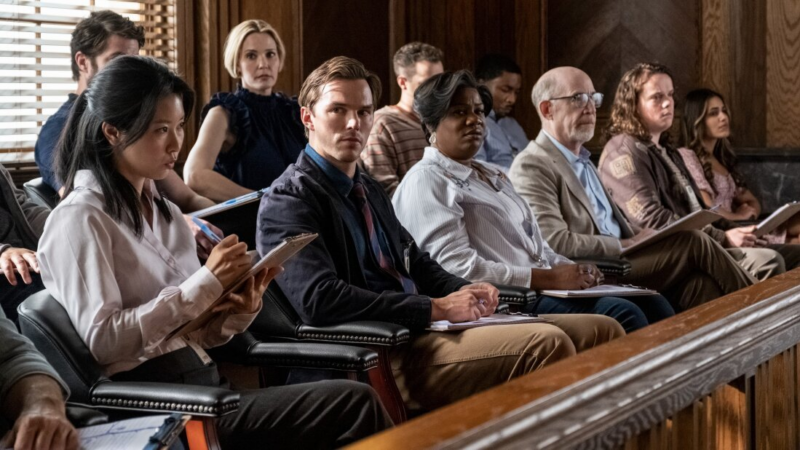Artist, scientist, polymath — a new documentary uncovers the real Leonardo da Vinci
More than half a millennium after his death, Leonardo da Vinci is still one of the most well-known artists in the world. The rare artist who, when you name some of his most iconic paintings, most people will immediately picture the artwork in their minds: the Mona Lisa, The Last Supper, his Vitruvian Man notebook sketches.
We have a lot of labels for da Vinci — artist, scientist, polymath — but a new documentary seeks to understand da Vinci as a person.
Documentary filmmakers Ken Burns, his daughter Sarah Burns, and her husband, David McMahon, are the co-directors of a new two-part miniseries called Leonardo da Vinci.
Ken and Sarah Burns sat down with All Things Considered host Scott Detrow to talk about what they learned about the human experience from studying da Vinci.
This interview has been lightly edited for length and clarity.
Interview highlights
Scott Detrow: Ken, I want to start with you. You have made a career out of telling American stories. What was it about Leonardo da Vinci that made you want to step outside that lane that you have carved so well?
Ken Burns: Sarah and Dave. I was an old dog that needed to be reminded that I could still learn a new trick. I’d had this sort of sense that I only did American topics. I think the rest sort of plows from that. They moved to Italy for a year to work on this, and sort of realize that this person is one of the most extraordinary gifts to humanity that we’ve ever had, arguably the person of the last millennium. And lots of people could make a run for that statement, but Leonardo is a hugely inspirational figure.

Scott Detrow: There are so many different elements of da Vinci that I think fascinate us 500-plus years later. What to you is his most remarkable aspect? What to you is the draw that makes you go, like, “I can’t I can’t believe he did that”?
Sarah Burns: I think it’s really his curiosity, and that’s what leads him to want to explore everything. He’s obsessed with nature and knowing everything there is to know about it, and that’s what leads him down all of these different paths that, to him, are entirely connected. He does not see boundaries between these disciplines that today we would say, “Art is over here and science is over here.” It’s all part of this grand experiment to try to understand the world. And so for him, it’s all process. And that’s the amazing thing about him is that he is looking at all of these things, and in each case, pushing it further, wanting to know more, asking more questions, rejecting authority in many cases on a subject, in order to figure out what the reality, the truth of this thing. And it’s extraordinary to see that.
Ken Burns: I think Sarah is right that this focus on nature and relentlessly questioning everything, it makes him see that it was necessary to know everything about the human body, the circulatory system, the skeletal system — the everything — in order to paint the Mona Lisa, and vice versa for these other things. So what happens is that what Leonardo leads you to is the essential essence of the human project. What is the nature of this universe? Why are we here? Why am I here? What is my purpose? Where am I going? These are essential questions that our daily life distracts us from. I mean, left us no kind of diaries of what he felt, but he left us thousands of pages of what he thought.

Scott Detrow: One of the most interesting things about da Vinci is the fact the guy was kind of a procrastinator. So many of these great paintings weren’t finished. So many of these commissions took a very long time. What do you make of that aspect of it?
Ken Burns: I think procrastination isn’t quite the right word. I think it’s really this relentless questioning of the universe, as Guillermo del Toro, the Mexican filmmaker, says in our film. So you see in a great painting like the Adoration of the Magi — that is an abandoned work — that perhaps the questions that he is asking have not been answered or won’t be answered by this particular project, and he’s moved away. So he’s not in the business of art. He has to survive, he has to get commissions, he has to live — but he’s about these higher pursuits. So he’ll walk away because he’s either satisfied or he’s not satisfied and needs to turn his attention to something else; to study water dynamics or to study the flight of birds, or to understand things about gravity or anatomy, or all of these things that he’s constantly pursuing. And he didn’t invent the helicopter or the submarine or these things, but he, in his drawings, prefigured our own pursuits later on. And that makes him incredibly modern.

Scott Detrow: I want to pause from the Renaissance for a moment and talk about current events. Because, Ken, we talked about the fact that this is a non-American subject that you tackle, but you have been telling the story of America throughout your career. And I have to ask, a week after this presidential election, what do you think the story of America over the past decade is? What is the story that’s happening right now, in the middle of the moment, at least? How are you thinking about the currents that we’re seeing and the choices the American people are making?
Ken Burns: The first thing is that you want to make sure that you don’t superimpose a story. You don’t want to tell people what it is. You have to let the story emerge. The other thing is that human nature never changes. So these are not unfamiliar events. Historians are, for the most part, happy because we know that there is existing precedent, and we know that people get through things and that there are challenging times and there’s unexpected parts. This is why documentary, to me, is so much more fruitful than making stuff up. And so I have to wait and give some distance. And so I think that what you have to do is exhale a little bit, and we cannot look away. We have to dedicate ourselves to telling complicated stories. And when you do that, then you’ve got the tools. I mean, there’s no greater teacher than the history you don’t know, and that allows you to meet a moment with a little bit more courage and a little bit more purpose and determination.
Scott Detrow: Let’s end on Renaissance Italy. And I want to end this interview by asking what your favorite work of art by Leonardo is, and why? Now this project is done and about to be shown to everybody, what are you still thinking about?
Sarah Burns: The one that moved me the most, I think just standing in front of it, was his Virgin and Child with Saint Anne. It’s larger than I had realized, and it’s been restored within the last decade or so, and so the colors are vibrant in a way that we unfortunately don’t always get with these paintings. I was stunned standing there. And we were lucky to get to go there and film overnight at the Louvre when it was empty, and sort of just experience it on our own, which was a really moving thing to be sort of up close and personal with that one.

Ken Burns: For me, I have an experience where I was scouting in advance of Sarah’s filming in 2019 and in an empty Louvre with the paintings going up, and I passed by this thing called the Virgin of the Rocks. And, you know, I read the thing, I went, “Huh.” You know, “Another great background and whatever.” And then, in our film, through an interview that Sarah and Dave did with Monsignor Timothy Verdon, a Catholic priest but also an art historian, he narrates a version of this painting that is new to me. And it woke me up from the person who saw it, that basically this woman who knows through all time that she is to bear the son of God who must die. Her maternal instincts in this painting, she’s trying to restrain John the Baptist. She’s trying to reach her son, but an angel isn’t there. And so you have, as he says, this larger purpose of drawing. You’re seeing a mother with the natural maternal instincts. And not just the people in three dimensions, but the intentions of their mind — what they’re feeling, what they’re thinking. And that, to me, is just what we’re all here about, all of us.
Sudan’s biggest refugee camp was already struck with famine. Now it’s being shelled
The siege, blamed on the Rapid Support Forces, has sparked a new humanitarian catastrophe and marks an alarming turning point in the Darfur region, already overrun by violence.
FDA approves weight loss drug Zepbound to treat obstructive sleep apnea
The FDA said studies have shown that by aiding weight loss, Zepbound improves sleep apnea symptoms in some patients.
Netflix is dreaming of a glitch-free Christmas with 2 major NFL games set
It comes weeks after Netflix's attempt to broadcast live boxing between Jake Paul and Mike Tyson was rife with technical glitches.
Opinion: The Pope wants priests to lighten up
A reflection on the comedy stylings of Pope Francis, who is telling priests to lighten up and not be so dour.
The FDA restricts a psychoactive mushroom used in some edibles
The Food and Drug Administration has told food manufacturers the psychoactive mushroom Amanita muscaria isn't authorized for food, including edibles, because it doesn't meet safety standards.
The jury’s in: You won’t miss anything watching this movie from the couch
There's been a bit of consternation flying around about the fact that the theatrical release of Juror #2, directed by Clint Eastwood, was very muted. But this movie is perfect to watch at home.







